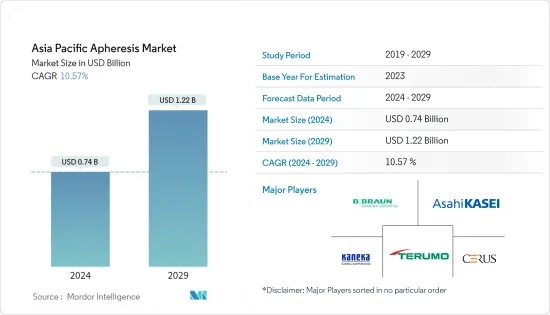PUBLISHER: Mordor Intelligence | PRODUCT CODE: 1433891

PUBLISHER: Mordor Intelligence | PRODUCT CODE: 1433891
Asia Pacific Apheresis - Market Share Analysis, Industry Trends & Statistics, Growth Forecasts (2024 - 2029)
The Asia Pacific Apheresis Market size is estimated at USD 0.74 billion in 2024, and is expected to reach USD 1.22 billion by 2029, growing at a CAGR of 10.57% during the forecast period (2024-2029).

The major factors attributing to the growth of the Asia Pacific apheresis market are increasing diseases burden, rise in demand for blood components and associated safety and technological advancement in the development of new apheresis techniques. However, the factors such as high capital investment and cost associated with apheresis procedures is expected to restrain the market.
Apheresis has now become a popular mode of treatment for multiple complex immune disorders and there has been a remarkable change in the scenario pertaining to therapeutic apheresis in Asia-Pacific. With the increasing number of diseases and accident cases, along with technological advancements, the market studied is expected to experience a boost during the forecast period. Additionally, the rising number of government initiatives, blood donation camps, and increasing awareness about healthcare are the factors responsible for the growth of the market studied. Apheresis technology is expensive. It is also technically and medically demanding.
APAC Apheresis Market Trends
Neurological Disorders is Expected to Grow with High CAGR in the Indication Segment
The pattern of neurologic diseases in Asia is largely similar to that in the western countries, with cerebrovascular diseases, headache, and epileptic seizures being the most common complaints.
Disease features that are specific to Asia include a high proportion of strokes among the youth, mostly from premature atherosclerosis, a high prevalence of intracranial vs extracranial diseases, the relative commonality of neuromyelitis optica and the optic-spinal form of multiple sclerosis (MS), and high incidences of sex-linked dystonia and Parkinson's disease. Plasma exchange is one of the well-established therapeutic procedures that is usually used in many neurological autoimmune disorders. It is thought that the effects of plasma exchange occur through the elimination of pathognomonic inflammatory mediators, including autoantibodies, complement components, and cytokines. Most of the neurological disease treatments are benefited with therapeutic apheresis, and these effects most likely occur through the removal of harmful pathogenic autoantibodies and associated inflammatory mediators.
APAC Apheresis Industry Overview
The Asia Pacific aphersis market is moderately competitive and consists of several major players. In terms of market share, few major players are currently dominate the apheresis market. With the increasing prevalence of diseases in the Asia pacific region and the usage of apheresis is expected to rise, thereby few other players are also expected into the market. Some of the major players of the market are Asahi Kasei Corporation, B. Braun Melsungen AG, Cerus Corporation, Kaneka Corporation and Terumo Corporation are among others.
Additional Benefits:
- The market estimate (ME) sheet in Excel format
- 3 months of analyst support
TABLE OF CONTENTS
1 INTRODUCTION
- 1.1 Study Deliverables
- 1.2 Study Assumptions
- 1.3 Scope of the Study
2 RESEARCH METHODOLOGY
3 EXECUTIVE SUMMARY
4 MARKET DYNAMICS
- 4.1 Market Overview
- 4.2 Market Drivers
- 4.2.1 Increasing Disease Burden in Asia
- 4.2.2 Rise in Demand for Blood Components and Associated Safety
- 4.2.3 Technological Advancement in the Development of New Apheresis Techniques
- 4.3 Market Restraints
- 4.3.1 High Capital Investment and Cost Associated with Apheresis Procedures
- 4.3.2 Risk of Blood Contamination
- 4.4 Porter's Five Force Analysis
- 4.4.1 Threat of New Entrants
- 4.4.2 Bargaining Power of Buyers/Consumers
- 4.4.3 Bargaining Power of Suppliers
- 4.4.4 Threat of Substitute Products
- 4.4.5 Intensity of Competitive Rivalry
5 MARKET SEGMENTATION
- 5.1 By Product
- 5.1.1 Devices
- 5.1.2 Disposables
- 5.2 By Indication
- 5.2.1 Renal Disorders
- 5.2.2 Hematological Disorders
- 5.2.3 Neurological Disorders
- 5.2.4 Autoimmune Disorders
- 5.2.5 Other Indications
- 5.3 By Procedure
- 5.3.1 Plasmapheresis
- 5.3.2 Plateletpheresis
- 5.3.3 Erythrocytapheresis
- 5.3.4 Leukapheresis
- 5.3.5 Other Procedures
- 5.4 Geography
- 5.4.1 China
- 5.4.2 Japan
- 5.4.3 India
- 5.4.4 Australia
- 5.4.5 South Korea
- 5.4.6 Rest of Asia Pacific
6 COMPETITIVE LANDSCAPE
- 6.1 Company Profiles
- 6.1.1 Asahi Kasei Corporation
- 6.1.2 B. Braun Melsungen AG
- 6.1.3 Cerus Corporation
- 6.1.4 Kaneka Corporation
- 6.1.5 Terumo Corporation
- 6.1.6 Fresenius SE & Co. KGaA
7 MARKET OPPORTUNITIES AND FUTURE TRENDS




